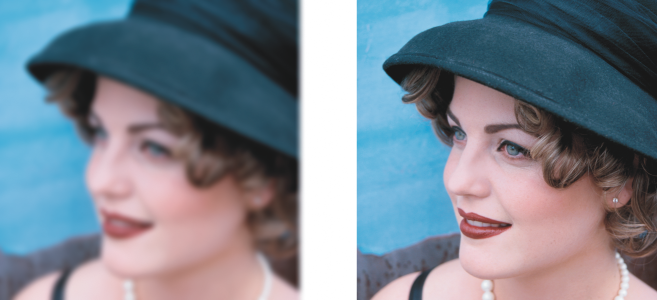
You can sharpen images to increase contrast, enhance image edges, or reduce shading. To sharpen an image, or an editable area of an image, you can use filters or brushstrokes. Filters can also be applied using a lens. For more information about lenses, see Create lenses. Sharpening is usually done after adjusting the color and tone of an image and after resampling or resizing.
You can reveal more image detail by sharpening an image.
| To sharpen an image by applying a filter |
|
| 1 . | Click Image |
| 2 . | Move the Percentage slider to set the amount of sharpening that is applied each time you click a thumbnail button. |
| 3 . | Click any of the following thumbnail buttons: |
| • | Unsharp Mask — lets you accentuate edge detail and focus blurred areas in the image without removing low-frequency areas. |
| • | Adaptive Unsharp — lets you accentuate edge detail by analyzing the values of neighboring pixels. This filter preserves most image detail, but its effect is most apparent in high-resolution images. |
| • | Sharpen — lets you accentuate the edges of the image by focusing blurred areas and increasing the contrast between neighboring pixels. Move the Background slider to set the threshold for the effect. Lower values increase the number of pixels changed by the sharpening effect. |
| • | Directional Sharpen — lets you enhance the edges of an image without creating a grainy effect. |
|
Click Effects
|
The Unsharp Mask filter provides best results for most photographs.
Most sharpen filters support all color modes except 48-bit RGB, 16-bit grayscale, paletted, and black-and-white. The Sharpen filter supports all color modes except paletted and black-and-white.
You can access each of the sharpen filters individually by clicking Effects ![]() Sharpen, and clicking a filter.
Sharpen, and clicking a filter.
You can use this procedure to sharpen an editable area of an image.
| To sharpen selected areas by applying brushstrokes |
|
| 1 . | In the toolbox, click the Effect tool |
| 2 . | On the property bar, open the Brush picker, click Sharpen, and then choose a brush. |
| 3 . | Choose a nib from the Nib shape picker. |
| 4 . | Type a value in the Nib size box to specify the nib size. |
| 5 . | Drag across an image area. |
You can quickly choose a square or round brush shape by clicking the Round nib button or the Square nib button
on the property bar.
You can apply the sharpening effect with symmetrical patterns by clicking Window ![]() Toolbars
Toolbars ![]() Symmetry, and choosing the settings you want on the Symmetry bar before dragging in the image window. For more information on the Symmetry bar, see To paint symmetrical patterns.
Symmetry, and choosing the settings you want on the Symmetry bar before dragging in the image window. For more information on the Symmetry bar, see To paint symmetrical patterns.
The features documented in the Help are available in the full version of CorelDRAW Graphics Suite 2019. Some features may not be available in this version of the product.